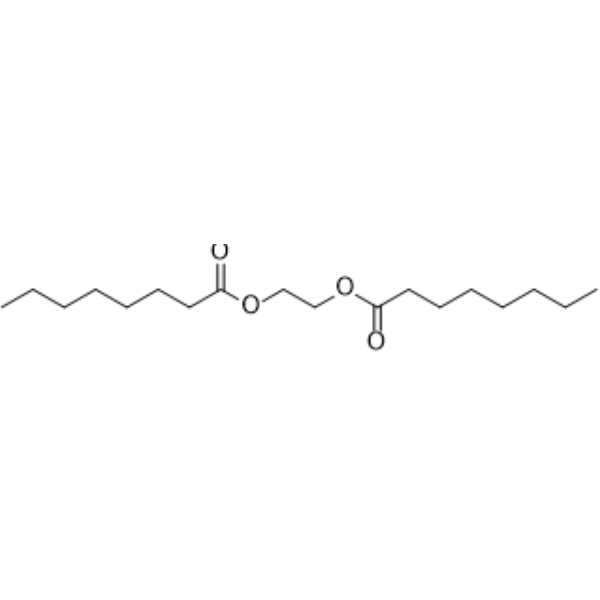
Dioctanoylglycol
CAS No. 627-86-1
Dioctanoylglycol( 2-octanoyloxyethyl octanoate | Dioctanoyl ethylene glycol | Ethylene glycol dioctanoate | ethane-1,2-diyl dioctanoate )
Catalog No. M27622 CAS No. 627-86-1
Dioctanoylglycol is a diacylglycerol kinase inhibitor.
Purity : >98% (HPLC)
 COA
COA
 Datasheet
Datasheet
 HNMR
HNMR
 HPLC
HPLC
 MSDS
MSDS
 Handing Instructions
Handing Instructions
| Size | Price / USD | Stock | Quantity |
| 10MG | 39 | Get Quote |


|
| 25MG | 80 | Get Quote |


|
| 50MG | 105 | Get Quote |


|
| 100MG | 168 | Get Quote |


|
| 500MG | 428 | Get Quote |


|
| 1G | Get Quote | Get Quote |


|
Biological Information
-
Product NameDioctanoylglycol
-
NoteResearch use only, not for human use.
-
Brief DescriptionDioctanoylglycol is a diacylglycerol kinase inhibitor.
-
DescriptionDioctanoylglycol is a diacylglycerol kinase inhibitor.
-
In VitroDioctanoylglycol (Dioctanoylethylene glycol) inhibits diacylglycerol phosphorylation in platelets (70-100% at 100 μM) leading to a longer-lived diacylglycerol signal.
-
In Vivo——
-
Synonyms2-octanoyloxyethyl octanoate | Dioctanoyl ethylene glycol | Ethylene glycol dioctanoate | ethane-1,2-diyl dioctanoate
-
PathwayOthers
-
TargetOther Targets
-
RecptorGPR39
-
Research Area——
-
Indication——
Chemical Information
-
CAS Number627-86-1
-
Formula Weight314.466
-
Molecular FormulaC18H34O4
-
Purity>98% (HPLC)
-
SolubilityIn Vitro:?DMSO : 100 mg/mL (318.01 mM)
-
SMILESCCCCCCCC(=O)OCCOC(=O)CCCCCCC
-
Chemical Name——
Shipping & Storage Information
-
Storage(-20℃)
-
ShippingWith Ice Pack
-
Stability≥ 2 years
Reference
1.Frimurer TM, et al. Model-Based Discovery of Synthetic Agonists for the Zn2+-Sensing G-Protein-Coupled Receptor 39 (GPR39) Reveals Novel Biological Functions. J Med Chem. 2017 Feb 9;60(3):886-898.
molnova catalog



related products
-
Lanreotide acetate
Lanreotide acetate (BIM 23014 acetate) has been used as an inhibitor to test the variability of h2s regulation in wild-type mice with growth hormone/thyroid hormone signal transduction.
-
Rebaudioside F
Rebaudioside F is a natural product.
-
Arecoline
Arecoline is an agonist at both muscarinic and nicotinic acetylcholine receptors. It is used in the form of various salts as a ganglionic stimulant, a parasympathomimetic, and a vermifuge, especially in veterinary practice.



 Cart
Cart
 sales@molnova.com
sales@molnova.com


